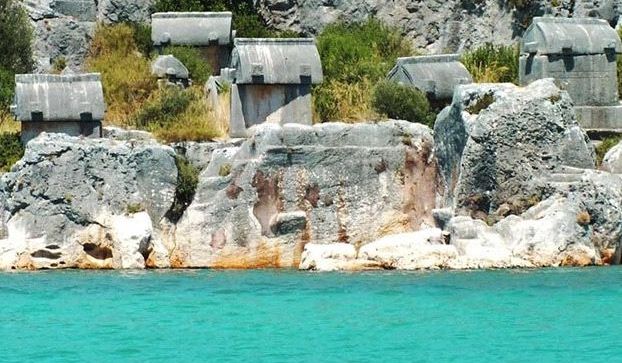Aperlai is one of the ancient cities encountered on the Lycian Way. After a 3-hour walk from Sahilkılınçlı village, Aperlai Ancient City, which was built on a hillside and suffered from earthquakes in the past, welcomes you. Aperlai, being a port city, owes its wealth to the expensive purple color production from sea snails. Aperlai is often mentioned with Apollonia, the closest city. After Aperlai city became rich, the people of Apollonia migrated here too.

Where is Aperlai Ancient City?
Aperlai is located in Antalya’s Demre district. On a slope where the rocks of Lycia are very difficult to live, Aperlaians settled on the shore of a small and narrow gulf.
History of Aperlai
The city was named “Aperlai”, which means “flowing strait” due to its location on the slope and the strong current between it and the island opposite. It was built on a slope by the sea. The narrow mouth of the gulf where the city is located opens to Kaş direction.
Aperlai was destroyed by two severe earthquakes that occurred in 141 and 240 AD. Some or all of the buildings went under the sea. Like other cities of Lycia, Aperlai also had a water problem and the water problem was solved thanks to many cisterns built in the city. There are approximately 40 cisterns discovered in Aperlai today.
Aperlai; Apollonia is the head of the union (Sympoliteia) where Isinda and Simena are located. These cities have a total of 2 votes in the Lycian Union.
Dolphins on the coins found in the city shows Aperlai’s connection with maritime. It is a rich city that processed “Purpur (also known as Murex, Phoenician red, Phoenician purple, royal purple, imperial purple, or imperial dye)” and produced and exported purple color during the Roman period. With its maritime and purpur trade, it attracted the attention of the Lycian elite. The fact that the rich Lycian man Opramoas made a great contribution to the city around 30000 Denaries shows this. The city was abandoned until the Arab invasion in 700 AD.
Things to See in Aperlai Ancient City
The ancient city of Aperlai was discovered in 1970-1971 when a tourist named Jack Carter saw some ruins underwater. The first ruin to be found in the city is the early Hellenistic watchtower on the north wall. No other remains belonging to this period are observed; However, the Roman and Byzantine periods are the period with the most remains are dated.
The south-end of the city, the port facilities, many urban buildings and part of the city walls were submerged as a result of the earthquakes. While the land of the city extends along a slope in the north-south direction, the northernmost point is approximately 70 m high. While only the foundations or walls of some sunken buildings remained, some buildings were completely ruined.
The city, where only about 1000 people believed to be living, does not have a theater and a stadium. An Agora, two baths, several general shops, murex workshops and other ruins have survived until today in Aperlai ancient City.
Harbor structures on the 250-meter-long coastline, which are buried underwater today, show the richness of the city in the Roman period. It is understood that the city was also busy during the Byzantine period thanks to the existence of four churches in the city.
Aperlai is an ancient Lycian city established as a coastal unit in which the settlements of Kyaneai and Apollonia regions open to the sea. Aperlai had an organic relationship with Antiphellos ports. Currently, no excavation has been carried out and the condition of the buildings does not allow for accurate identification of uses after prolonged submersion.
Aperlai and Murex, the Purple Treasure
There are workshops in Aperlai where the purple-red mixture color extract was obtained. The terrible smells emitted by the seashells smashed with iron rods and processed in the oven suggest that the shores of the past Aperlai were not places that were visited with such pleasure as they are today. This colorant was an expensive export product.
Since the high salt content in this valuable liquid prevents it from being preserved for a long time, honey was added and stored. In Aperlai, piled crust mounds and storage tanks used to keep the murex alive were found, indicating that purple and red were obtained from murex. The mounds formed from the waste of murex in the empty storages in the west of the city show us that Aperlai produced a significant amount. In addition, amphoras used in carrying murex belonging to the Late Roman period were found in the city.
Lycian tombs in Aperlai
It is interesting that no Lycian rock tombs have been found in the necropolis of the city, which is located outside the city wall, although more than 80 tombs have been identified. Since underwater archeology is a very new field, old travelers and early archaeologists who are accustomed to terrestrial studies have not been able to reach what lies beneath the waters. For this reason, like other coastal settlements, many of its ruins are waiting underwater, waiting to be researched.
Tour Guide to Aperlai
Aperlai Ruins have always been an interesting stop for me when I guide my Lycian Way tours. Contact me to learn more on Aperlai and to hire a professional licensed Turkish tour guide to Aperlai, Turkey. See you soon, Hasan Gülday.